
How to Manage Email Overload and Reclaim Your Day
Feeling buried by emails? Learn how to manage email overload with proven strategies that go beyond inbox zero. Reclaim your focus and boost productivity today.
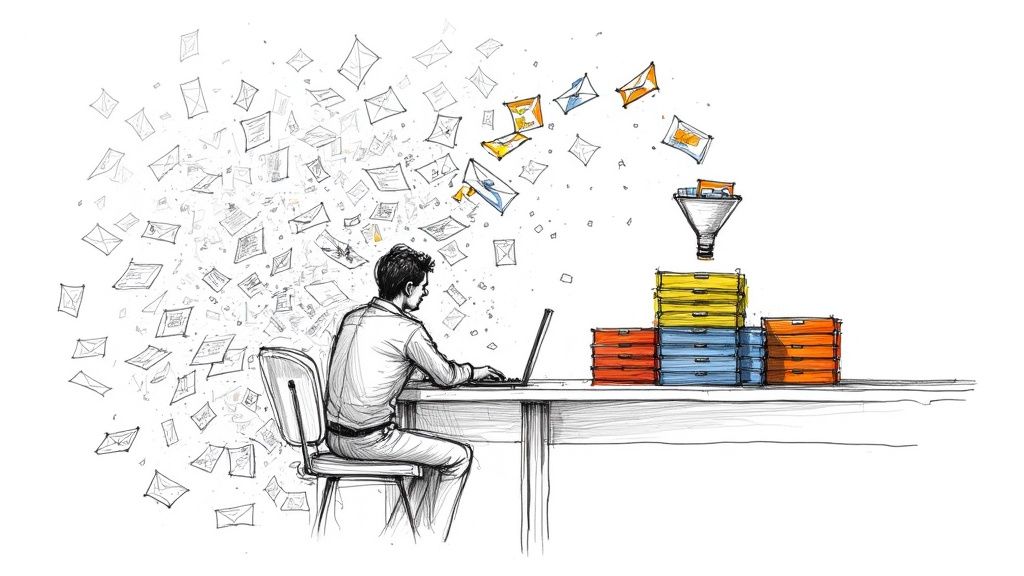
If you want to get a handle on email, you have to do more than just clean out your inbox. It’s a combination of changing your mindset, building smart systems, and using the right tools. The people who are truly on top of their game don’t just reply faster; they have a completely different relationship with their inbox, transforming it from a source of daily stress into a powerful asset.
The True Cost of a Never-Ending Inbox
Let's be real—email overload is more than just an annoyance. It’s a constant drag on your focus, a hidden source of stress, and a major roadblock to getting any meaningful work done. Every time you hear that "ping," it’s not just an interruption. It's a mental gear shift that pulls you out of deep thinking and scatters your attention.
And this isn't just a personal feeling; it's a massive, global issue. By 2025, it's estimated there will be 4.83 billion email users sending around 392 billion emails every single day. That firehose of communication is only getting stronger, with projections hitting 523 billion daily emails by 2030. The floodgates aren't closing anytime soon.
The Hidden Price of a Full Inbox
The most obvious cost is wasted time, but the real damage goes much deeper. Every single email, no matter how trivial, forces you to make a quick decision: Reply? Archive? Defer? Delete? This relentless cycle of tiny choices leads directly to decision fatigue, draining the mental fuel you desperately need for your most important work.
Beyond the time suck, there's a heavy psychological toll. The constant connectivity blurs the lines between your work and personal life, creating a state of perpetual "on-call" anxiety. If this sounds familiar, it's worth reading up on the dark side of email addiction and how to break free.
The real goal isn't just to have an empty inbox, but a clear mind. It's about building a system you trust so completely that you know nothing important is slipping through the cracks, freeing you up to focus on the task at hand.
Building Your Road to Recovery
To actually beat email overload, you need a plan. Randomly trying tips you find online won't cut it. Instead, you need a structured approach built on a few core strategies. This gives you a clear roadmap for the tactics we’re about to dive into. If you want a head start, you can explore more of our essential email management tips right away.
This guide gives you a quick overview of the core strategies you'll learn, providing a clear roadmap to finally gaining control over your inbox.
The Four Pillars of Email Mastery
| Strategy Pillar | Core Action | Expected Outcome |
|---|---|---|
| Mindset | Shift from reactive checking to proactive scheduling. | Less stress, more focused work, and intentional communication. |
| System | Create a repeatable process for handling every email. | A consistently organized inbox where nothing gets lost. |
| Automation | Use tools to manage repetitive, low-value tasks. | More time and mental energy for high-impact activities. |
| Communication | Write clearer emails that prevent endless back-and-forth. | Fewer emails overall and faster resolutions to discussions. |
By focusing on these four pillars, you're not just cleaning up your inbox for a day. You're building a sustainable system that turns your email from a chaotic mess into one of your most powerful productivity tools.
Building a Proactive Email Mindset
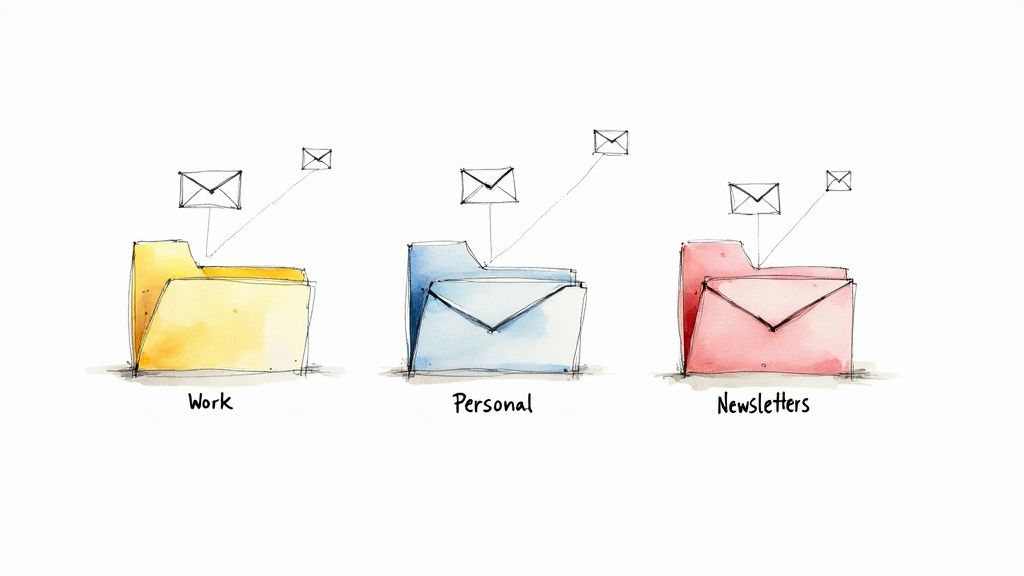 Before you create a single folder or filter, the most important change you can make happens between your ears. It’s a fundamental shift in how you see your inbox—from a reactive mess to a proactive system you control. The goal is simple but powerful: stop letting email dictate your day and start telling it when it gets your attention.
Before you create a single folder or filter, the most important change you can make happens between your ears. It’s a fundamental shift in how you see your inbox—from a reactive mess to a proactive system you control. The goal is simple but powerful: stop letting email dictate your day and start telling it when it gets your attention.
This is where so many people get stuck. They treat their inbox like a to-do list written by everyone else, allowing every new message to derail their focus. High-performers, on the other hand, have flipped this script. They see their inbox not as an emergency room demanding constant triage, but as a mailbox to be checked at designated times.
Reclaim Your Focus with Email Windows
The first practical step is to establish "email windows." This just means setting aside specific, scheduled blocks of time each day to process your email. It's a world away from keeping your inbox open all day long.
Think about your physical mailbox at home. You don't stand by it all day waiting for the mail to arrive, do you? You check it once, sort through what’s there, and get on with your life. Apply that exact same logic to your digital mailbox.
A good starting schedule might look something like this:
- 9:00 AM - 9:30 AM: A first check to handle anything urgent that came in overnight and to help plan your day.
- 1:00 PM - 1:30 PM: A midday sweep to clear out new messages and handle any mid-day requests.
- 4:30 PM - 5:00 PM: One final check to close out the workday, making sure nothing critical is left hanging.
Between these windows, your email tab is closed. This simple act creates huge, uninterrupted blocks of time for deep, focused work—the kind of work that actually moves the needle on your most important projects.
The most productive people don't have more hours in the day; they have more control over their attention. Protecting your focus from the constant "ping" of new emails is the single most effective way to regain that control.
Silence the Sirens and Take Back Control
To make email windows truly work, you have to turn off your notifications. This part is non-negotiable. Every alert—the desktop pop-ups, the phone buzzes, the little red badges—is a tiny interruption that shatters your concentration. Each one pulls you out of your workflow and forces your brain to switch contexts, a process that burns a surprising amount of mental energy.
One study found it can take over 23 minutes to fully get back on track after a single interruption. Imagine that happening a dozen times before lunch. It’s no wonder so many of us feel like we’re spinning our wheels. Silencing these digital sirens is a crucial step, and you can find more strategies for it in our guide on how to create a productive workspace.
This proactive approach isn't just about what you receive; it's also about what you send. You can cut down on the email you have to manage by being more mindful about the email you create. Think about shifting quick, back-and-forth conversations to a more suitable platform like an instant message or a quick call. You’d be surprised how many long, drawn-out email chains could have been avoided entirely.
By putting these small behavioral changes into practice—scheduling email windows, killing notifications, and processing messages on your terms—you make a conscious decision to be the master of your inbox, not its servant. This mental shift is the foundation for everything else, and it will dramatically reduce your stress while putting you firmly back in control.
Designing Your High-Efficiency Inbox System
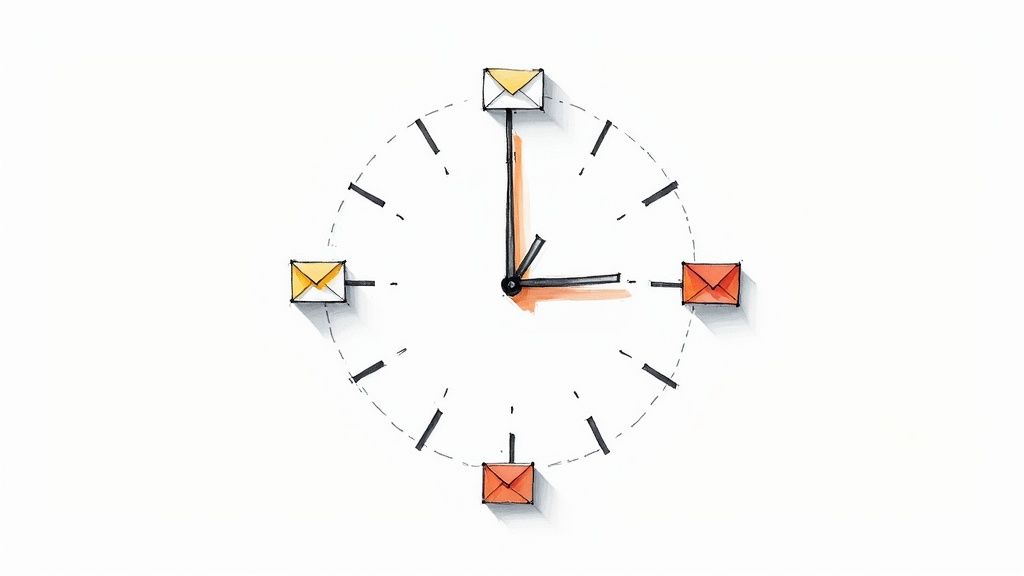
Alright, with a proactive mindset locked in, you’re ready to build an inbox that actually works for you. This isn’t about some magic app. It's about creating a simple, repeatable system for processing information so you can kill the mental clutter and make a clear decision on every single message you see.
The absolute bedrock of this system is the "One-Touch" rule. It’s a powerful commitment: when you open an email, you deal with it completely, right then and there. No more reading it, closing it, and letting it haunt you until later. This one habit stops that pile-up of half-handled tasks that absolutely drains your focus.
Think about it—every time you re-read an email, you're just wasting brainpower. The One-Touch rule forces you to stop using your inbox as a messy, accidental to-do list and moves you from just reading to actually doing.
Embrace Batch Processing for Peak Efficiency
To make the One-Touch rule stick, you have to pair it with batch processing. This is simply the act of putting your "email windows" strategy into practice. Instead of letting every new email notification derail your day, you process them in focused, scheduled sprints.
During your dedicated email time, you open your inbox and just work through the messages methodically, applying the One-Touch principle to each one. You’d be amazed at how fast you can clear a backlog when you aren't constantly switching gears between your inbox and your real work.
I once coached a project manager who was drowning in email. We had her block out 9:00 to 9:30 AM every morning. In that short window, she sorted overnight messages, delegated tasks, fired off quick replies, and archived everything else. Just like that, her inbox was clear, and she could focus entirely on project planning until her next email batch after lunch.
The big idea here is to treat your inbox like a stack of physical mail. You sort it, you action it, and you file it away. You don’t leave it scattered all over your desk to re-read a dozen times. This system brings that same clarity to your digital world.
Simplify Your Sorting with a Minimalist Label System
Forget those ridiculously complex, nested folder structures that just become digital junk drawers. An effective system relies on a few simple, action-oriented labels. A complicated hierarchy is a nightmare to maintain and, ironically, makes finding things harder. All you really need is a basic framework to separate what needs doing from what's already done.
Here’s a proven, simple label system you can set up in Gmail or Outlook in about five minutes:
- Action: For any email that requires a task from you that’ll take more than two minutes. This becomes your curated to-do list, not just a random pile of requests.
- Waiting: For messages where you've delegated something or are waiting for a reply. This is your personal follow-up file.
- Archive: Your digital filing cabinet. Once an email is handled, it goes here. Search is so good these days; you don’t need intricate folders anymore.
With this streamlined approach, any email in your main inbox is new and unprocessed. Everything else you've touched is either in one of two temporary states (Action or Waiting) or filed away forever in the Archive.
Put Your System on Autopilot with Rules and Filters
Now for the fun part: automation. Manually sorting every single email is a terrible use of your time. Instead, you can create rules (if you're in Outlook) or filters (in Gmail) to do the heavy lifting for you. This is a game-changer for anyone serious about managing email overload.
Just think about the recurring emails you get and set up rules to handle them before you even see them. This pre-sorting ensures that when you sit down for your batch session, you’re only dealing with messages that truly need your attention.
Here are a few real-world examples to get you started:
- Project Updates: Create a filter that automatically slaps a "Project Phoenix" label on any email that contains the project's code name or comes from key stakeholders.
- Newsletters & Subscriptions: Set up a rule to move all incoming newsletters directly to a "Reading" folder, completely skipping the inbox. You can binge-read them later.
- The Dreaded CC: Filter messages where you are only on the CC line to bypass the inbox and go straight to a "Low Priority" or "Review Later" folder.
By designing this kind of high-efficiency system, you transform your inbox from a chaotic stream of demands into an organized command center. For more in-depth strategies, you can explore comprehensive guides on mastering email inbox management.
Next, we'll look at how to supercharge this system with tools that can take your automation to a whole new level.
Put Your Email on Autopilot with Tooling Studio
Alright, you’ve adopted a proactive mindset and built a solid system for handling your inbox. But let's be honest—manually applying labels and sorting every single message still eats up time and mental energy. True mastery over your email comes when you put that system on autopilot. You need to let technology handle the grunt work so you can focus on what actually matters.
This is where the right tools become your secret weapon. I'm not talking about adding another bloated, complex platform to your tech stack. The best tools work inside your existing inbox, giving it superpowers without forcing you to change your entire workflow. This is exactly what Tooling Studio’s Chrome extensions were built for.
They aren’t separate apps you have to constantly switch to. Instead, they embed powerful automation features right into your Gmail interface, making your new system not just effective, but completely effortless.
Finally Make the One-Touch Rule a Reality with AI
One of the biggest hurdles to the "One-Touch" rule? Those ridiculously long and confusing email threads. You open a message only to find a novel-length chain of 15 replies you have to sift through just to figure out what's going on. It’s impossible to "touch it once" when it takes ten minutes just to get up to speed.
This is where AI-powered summarization is a game-changer. Tooling Studio’s extension can scan an entire email chain and spit out a clean, concise summary in seconds.
Imagine a project update thread that’s spiraled out of control. Instead of reading every back-and-forth, you get a quick, bulleted list of the key decisions, who’s responsible for what, and any open questions. This lets you grasp the entire situation instantly and make a decision—reply, delegate, or archive—without getting lost in the weeds. A ten-minute chore just became a 30-second task.
Stop Inbox Clutter at the Source
Even with the best filters, your inbox is under constant assault from newsletters, promotional junk, and random subscriptions you swear you never signed up for. Manually hunting for that tiny "unsubscribe" link buried in the footer of each email is a soul-crushing chore.
Here again, simple automation brings massive relief. A one-click unsubscribe tool built directly into your inbox changes everything.
Instead of playing detective, a button appears at the top of any promotional email. One click, and you're instantly and permanently off that mailing list. Making this a habit for just a few weeks can dramatically reduce incoming noise, effectively shutting off the junk mail firehose at its source.
The most effective way to manage your inbox is to reduce the number of emails that land there in the first place. Automating the unsubscribe process is the fastest path to a cleaner, quieter inbox for good.
Cut Your Reply Time in Half with Smart Templates
We all write the same emails over and over. Acknowledging a new lead, asking for a status update, answering a common question—these repetitive replies are a huge time sink. While Gmail has a basic template feature, it's often clunky and lacks the flexibility you need for truly personal-feeling communication.
This is where smart templates, or "canned responses," are invaluable. Tooling Studio takes this a step further by letting you create, save, and insert detailed templates with just a couple of clicks.
You can craft the perfect responses for your most frequent scenarios, complete with placeholders for names, project details, or specific dates. When it's time to reply, you just pick the right template, fill in the blanks, and hit send. A carefully worded response that used to take five minutes to type from scratch is now out the door in 30 seconds.
This infographic breaks down the basic flow for setting up automated sorting in your inbox, which is exactly what tools like Tooling Studio help you manage.
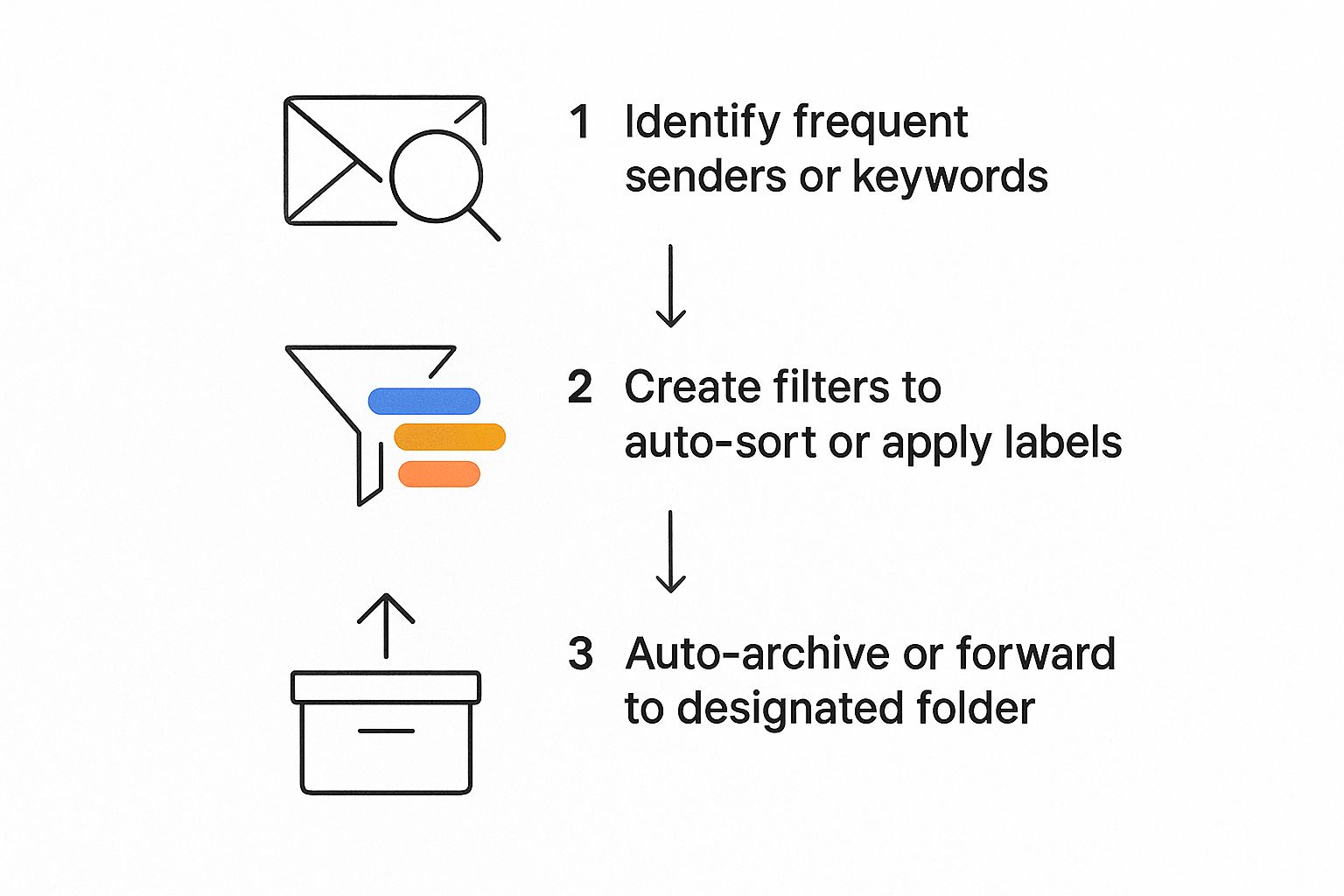 As you can see, the path from identifying repetitive emails to filtering them automatically is the core logic behind powerful email automation.
As you can see, the path from identifying repetitive emails to filtering them automatically is the core logic behind powerful email automation.
See Your Entire Workflow Right Inside Gmail
Let’s face it: your inbox is a terrible project manager. Important emails related to tasks and projects get buried in minutes, making it impossible to see the big picture of who is doing what. This confusion inevitably leads to more follow-up emails, creating a vicious cycle of inbox chaos.
Tooling Studio tackles this head-on by integrating a visual Kanban board directly into Gmail. This feature allows you to turn any email into a task on a shared board without ever having to leave your inbox.
You can see here how Tooling Studio's extensions look inside the Google environment.
 The tools blend seamlessly into the interface, adding powerful functionality without creating a clunky or jarring experience.
The tools blend seamlessly into the interface, adding powerful functionality without creating a clunky or jarring experience.
By weaving these automations directly into your daily workflow, you’re doing more than just managing email overload—you're turning your inbox into a command center. You're building a system that anticipates your needs, handles the low-value work for you, and frees up your time and mental space for the work that actually moves the needle.
Writing Better Emails to Get Fewer Replies
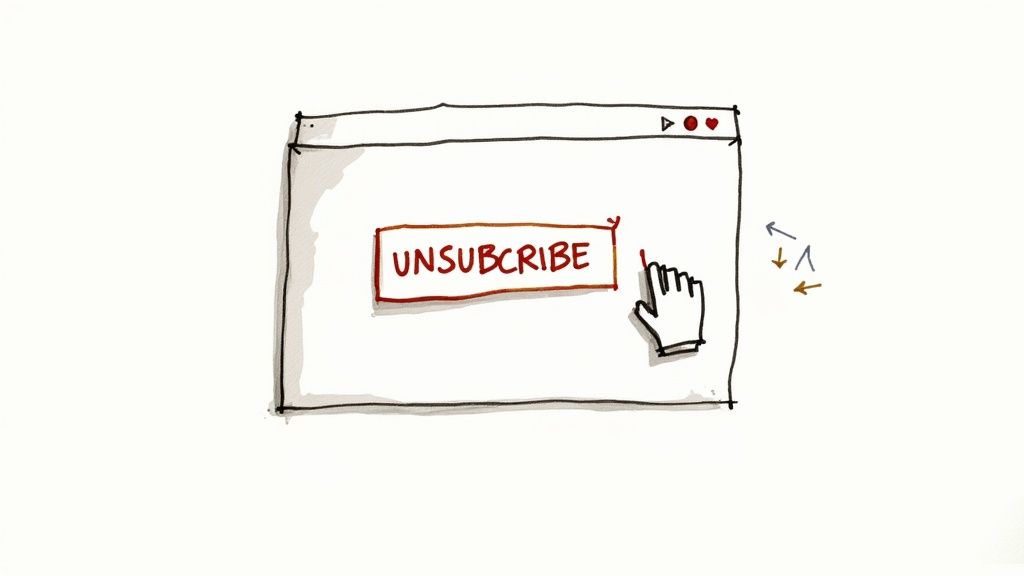
Here's a thought: a huge part of managing email overload has nothing to do with your inbox. It's all about your "outbox." The clarity and quality of the emails you send have a direct—and massive—impact on how many you get back.
I like to call it defensive emailing. By being more intentional with your communication, you can head off those endless, confusing back-and-forth chains that clog up everyone's day. A little proactive effort respects your recipient's time and, as a bonus, drastically cuts down your own incoming mail.
Craft Subject Lines That Act as Summaries
The first thing anyone sees is your subject line. Don't waste that prime real estate on vague phrases like "Quick question" or "Project Update." A great subject line is a mini-summary of the entire email, telling the reader exactly what to expect and what you need from them.
- Vague: "Meeting Follow-up"
- Clear: "ACTION REQUIRED: Please Approve Q3 Marketing Budget by EOD Friday"
A descriptive subject line lets the recipient prioritize your message instantly. They know what's inside and what's needed without even opening it, which often leads to a faster, more decisive response. This simple change is one of the most powerful ways to cut through the noise.
Get Straight to the Point
Your very first sentence should state your main point or request. So many emails I see start with lines of pleasantries and backstory before finally getting to the actual reason for the message. This buries the lead and forces your reader to hunt for why you're even writing.
This front-loading technique is sometimes called BLUF—Bottom Line Up Front. It’s a communication style used in the military for its crystal-clear efficiency. You just provide the conclusion first, then the context.
The goal is to make your email so clear that the recipient can grasp the main takeaway just by glancing at the first paragraph. Respect their time, and you're far more likely to get the quick, definitive answer you're looking for.
Use Formatting to Guide the Reader
Let's be honest: no one wants to read a giant wall of text, especially on a phone screen. Breaking up your message with simple formatting makes it scannable and easy to digest. This isn’t about making it look pretty; it’s about making it functional.
These formatting elements are your best friends:
- Bullet Points: Perfect for listing action items, questions, or key pieces of information. They draw the eye and make complex details easy to process.
- Numbered Lists: Use these when the order of steps is important, like for instructions or a sequence of events.
- Bold Text: Strategically use bolding to highlight critical details, deadlines, or the names of people responsible for tasks. Don't overdo it, but use it to make sure the most important parts simply can't be missed.
To really streamline your email workflow, you can also explore different strategies on how to write emails faster.
Close with a Clear Call to Action
End your email by explicitly stating what needs to happen next. Never, ever leave your recipient guessing. A weak closing like "Let me know your thoughts" is just an open invitation for a long, rambling reply.
Instead, be specific and direct. Frame your closing as a clear choice or a direct question.
| Vague Closing | Clear Closing |
|---|---|
| "What do you think?" | "Can you approve this draft by Tuesday?" |
| "Looking forward to hearing from you." | "Please let me know if you prefer Option A or Option B." |
| "Let me know if you have questions." | "No reply needed if you are in agreement." |
This approach doesn't just save the recipient time—it also prevents the kind of vague replies that force you to send another email for clarification. By improving your sending habits, you directly contribute to solving your own email overload problem. For more great ways to improve your daily digital routines, check out our guide on the top 10 productivity hacks for Google Chrome.
Your Top Email Management Questions, Answered
Jumping into a mission to tame your inbox always brings up a few practical questions and "what if" scenarios. Getting a handle on email overload is a process, and it's totally normal to hit a few roadblocks. I've been there.
Let's walk through some of the most common questions I hear. My goal is to give you clear, straightforward answers to keep you on track and in control for the long haul.
How Long Until I See Real Results?
This is the big one, and the answer really comes in two parts. You can feel immediate relief after just one solid afternoon of work. Seriously. Spend a few hours setting up a basic label system, creating a handful of filters, and blasting through your backlog—you’ll instantly feel less stressed with that clean slate.
But the real, lasting change? That comes from consistency. Once you start applying these strategies daily, especially batch processing and the one-touch rule, you’ll notice a huge drop in your background anxiety within the first week. True, sustainable habits usually lock in after about three to four weeks. At that point, managing email becomes a natural, almost subconscious part of your workflow.
Is Inbox Zero a Realistic Goal?
Ah, "Inbox Zero." It's a popular idea, but honestly, it’s not always a healthy or even useful goal for most people. Chasing a literally empty inbox can create more anxiety than it solves, especially when you're getting slammed with messages.
A much better, more sustainable target is what I call "Inbox Control."
Inbox Control means your inbox only holds new, unprocessed items or emails you've intentionally left as a to-do reminder. The number itself doesn't matter. What matters is the feeling that nothing important is slipping through the cracks. That's the real win.
Focus on building a system you can trust. A tidy inbox is a nice bonus, but a reliable process that keeps you organized and in command is what actually moves the needle.
Will Another Tool Just Add More Complexity?
It's a fair question. The last thing anyone needs is another app to learn or another tab to keep open. But the right tools are specifically built to reduce complexity, not add to it.
That’s the whole philosophy behind tools like Tooling Studio’s Chrome extensions. They don't force you into a separate platform. Instead, they weave themselves right into the email client you already live in. They work by automating the most mind-numbing, repetitive tasks—saving you countless clicks and a ton of mental energy on every single email.
Think of it less like buying a second car and more like upgrading the engine in the one you already love to drive.
What If I Fall Behind After Setting Everything Up?
Let's be real: it's not a matter of if you'll fall behind, but when. An unexpected project, a family emergency, or even just a week of vacation can turn your pristine system into a temporary mess. It happens to everyone, including me.
The key is not to get discouraged and throw your hands up, declaring the whole system a failure. A good system isn't about maintaining perfection 24/7. It's about having a clear, repeatable process to get back on track quickly.
When you feel that wave of overwhelm, just do this:
- Block out a 30-minute "reset" session on your calendar.
- Use that time for a quick triage. Archive anything non-essential, deal with the one or two truly urgent messages, and label anything that needs action for later.
- That's it. You're back to your baseline.
This ability to reset fast is the true sign of a successful email strategy. It's built for the real world, not some idealized fantasy.
Ready to stop fighting your inbox and start making it work for you? The Tooling Studio extensions integrate directly into your Gmail, putting powerful automation and organization features right where you need them. Transform your inbox into a productivity powerhouse with Tooling Studio today.